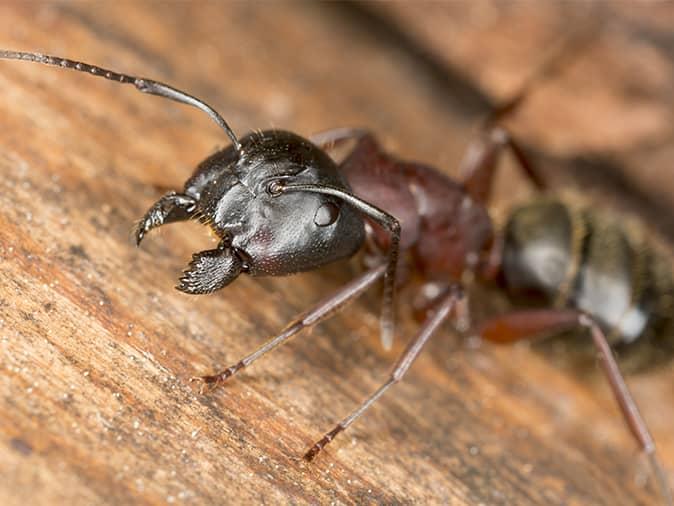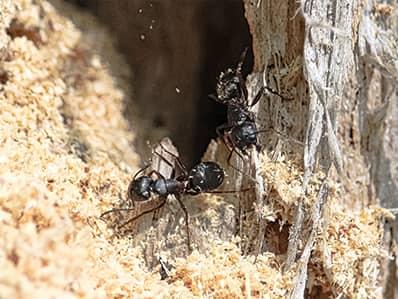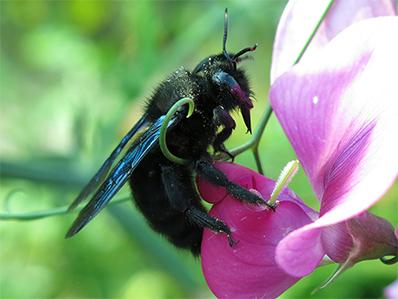What pest is responsible for the damage to your home?
Have you uncovered damages in your home but are not sure who or what the culprit is? Figuring out which pest is responsible for damage to support beams, walls, window frames, and other parts of the structure can be a lot like an episode of CSI and unfortunately, for homeowners in Mendham, Scotch Plains, and Parsippany-Troy Hills as well as throughout New Jersey, there are several wood-destroying insects that could be responsible for damaging your home. We’re going to discuss two of these pests more in depth shortly but before we do, we still have a couple of points to make. Bear with us.
Wood-destroying insect identification
Carpenter bees, for example, bore circular tunnels in untreated wood. These holes are about the size of a nickel. If this is the kind of damage you're seeing and it’s on the exterior of the house, you're not dealing with carpenter ants or termites, but carpenter bees!
Now, if you're seeing lots of tiny holes, those aren't carpenter bee holes. Instead, they could be the work of a smaller wood-destroying insect such as the carpenter ant. But not all tiny holes are created by carpenter ants. Powder post beetles can create tiny holes as well.
So, if you’re seeing these signs, you have to consider what type of wood is being damaged to figure out whether or not you have a powder post beetle infestation or a carpenter ant infestation. Powder post beetles prefer hardwood and often attack furniture as well as hardwood building materials whereas carpenter ants are more likely to target softwood, especially softwood that is rotting or has been water damaged.
That’s enough with examples, we think you get the point we’re trying to make. To learn more about the most common types of wood-destroying insects in New Jersey, visit the pest guides hyperlinked below.
Carpenter ants vs. termites
In this article, we really want to focus on carpenter ants and termites as they are the most destructive of all the wood-destroying insects in our state. Our goal is to equip you with a basic understanding of the diet, behavior, and habitat preferences of both carpenter ants and termites to help you piece the clues together and figure out which of these destructive pests you're dealing with on your property.
How termites and carpenter ants behave

There are some behaviors that subterranean termites exhibit that can help you identify the damages they cause. The most important of these behaviors is the construction of shelter tubes. Subterranean termite workers have thin skins that dry out quickly when exposed to sunlight. For this reason, these termite workers must build tubes made from moist soil in order to damage the wood of your home, especially if you have no areas where there is no wood-to-soil contact between the home and the soil surrounding it.
Termite shelter tubes are about the width of a pencil but they can be compacted together and appear much more substantial. If you are seeing wood damages to your home, search for the presence of compacted soil. It may be stuck to the outside of the wood or you may detect a grittiness inside the exposed tunneling.
Carpenter ants do not build mud tubes but rather travel on the surface.
Carpenter ants and subterranean termites are both drawn to wood that has been damaged by moisture. Softwood is an easy meal for subterranean termites and easy for carpenter ant workers to excavate but, of the two, subterranean termites have a far greater preference for softwood. For this reason, the damages that termite workers cause will follow the natural wood grain, which is softer. Carpenter ants will chew along the grain as well as across the grain.
While both wood-destroying pests tunnel their way through wood, it is important to note that the tunnels carpenter ants create are smooth, almost like they’ve been sanded. Also, the tunnels will be clean and clear of debris. In fact, carpenter ants will push frass out of their tunnels through the small holes they create on the surface. Because this ties into the differences in their diets, we’ll revisit this point in just a moment.
Carpenter ants don’t eat wood, termites do
First of all, carpenter ants don't actually eat wood. This is really important to understand when you're diagnosing wood damage. Carpenter ants tunnel galleries inside wood in order to establish a safe location to build their nests in. When they do this, they have to do something with all the wood that they chewed through. This chewed-up wood is called frass and is a fine, sawdust-like material. Sometimes, it’s so fine that it clings to walls when it is pushed out of the tiny kickout holes created by carpenter ant workers. The presence of this frass is a helpful clue when determining what insect is the cause of the damage you're seeing. Frass can appear pouring out of a gap in the wall, piled in front of a recess, littered under a baseboard, built up around the base of a door or window frame, and more. But it’s important to understand that frass is not always pushed out where you can see it. Oftentimes, frass can build up inside the voids within walls, ceilings, and floors. And when this happens, it can be harder to tell which pest is damaging your home.
Subterranean termites, on the other hand, do consume the wood they tunnel through. Therefore, they have no need to push this sawdust-like material out of their tunnels. Some termite species do, however, push pellets out of kickout holes. These tiny pellets are also called frass, but they are not sawdust; they are actually the waste products of those termites. The termites that push these droppings out of their tunnels are drywood termites. These termites are not established in New Jersey but can be brought into homes inside furniture items that have been transported from a state that has a distribution of these insects. Usually, when we talk about the termites in New Jersey, we're referring to subterranean termites.
Habitat preferences
The termites in our area are aptly named subterranean termites as they live primarily underground. In fact, none of the termite species found in our area create satellite colonies above ground. Carpenter ants, on the other hand, are prone to creating nests above ground. Their nests can often be found in logs and trees as well as inside the wood of homes. This difference in habitat preferences makes it more likely that damages found around window and door frames are the work of carpenter ants. These ants can chew their way into a home through vulnerable areas in the exterior then find a cool, moist location inside to establish their nest. Window and door frames are notorious entry points for these pests as they are typically high-moisture zones.
Signs of termite damage or carpenter ant damage inside

When these insects invade your home, most of the damages they create will be in places you can't see. In fact, subterranean termites are even known to feed up to the paint on a wall and stop just short of breaking through. If you see bubbling paint on your wall, it may be a warning sign of termite activity. However, most of the time, you're not going to see any of the damages caused by termites. Oftentimes, you won't see carpenter ant damages to your home either. And, over time, you may begin to notice that your windows are beginning to stick or open and close freely, your doors are beginning to stick, your ceilings are starting to sink or your floors are dipping feel spongy to walk on, or your walls are starting to bulge out. These are all signs that your home is being damaged by wood-destroying insects. Does it matter by which? Well, yes it does. But no matter what, those insects need to be stopped!
Since both of these insects can damage your home’s structural wood and are active inside the voids of your home where you can't see them, it is best to have a pest control professional perform an inspection and assess the threat of the infestation you’re dealing with. If not properly tracked and effectively treated, these wood-destroying pests can do a lot of damage to your home over time.
In the United States alone, subterranean termites cost home and business owners over $5 billion in structural damages annually, and carpenter ant repairs total in the hundreds of millions. The worst part is that the damages done by these insects can be difficult or impossible to repair. These damages can be done deep inside the timbers of a home and there is no way to know exactly where this damage has been done or just how much damage has been done your house to know exactly where this damage has been done until it’s too late. Don't take that chance. Hire a trusted pest control expert to protect your equity!
Professional termite control and carpenter ant control services
At Arrow Pest Control, our pest professionals use the most advanced technologies and methods to find termites and carpenter ants and eliminate them from homes and businesses. We have a strong track record of success and the review our customers give us on our social media is a testament to this success. It is impossible to have a 5 out of 5 stars on 1260 reviews at Google without paying meticulous attention to details and providing quality services with long-lasting results. For effective termite control and carpenter ant control you can depend on, call the experts at Arrow Pest Control today!
Arrow Premier
If you’re looking for a program that protects your home and family from common household pests PLUS termites and other wood-destroying insects, we recommend Arrow Premier. With this program, you get quarterly pest control and a wood-destroying insect program in one package!
- Protects your home all year long.
- Consists of full interior and exterior inspections and treatments.
- Covers your entire property* including the attic, mailbox, play set, shed, and fence.
- Includes a certified termite inspection and ongoing termite control.
Pests targeted with Arrow’s Premier includes cockroaches, silverfish, spiders, earwigs, clover mites, millipedes, centipedes, crickets, ground beetles, boxelder bugs, ants (including carpenter ants, pharaoh ants and acrobatic), fleas (inside only), pillbugs, sow bugs, fruit flies, stored product pests, bees, wasps, hornets, carpenter bees (no higher than 10ft), mice, and rodents PLUS termites
*If you have a pool house that requires service, pricing would increase based upon the size of the structure.


Testimonials
Request Your FREE Estimate
Additional Services
Our solutions are designed for even your toughest pest problems.
Don’t let pests affect your quality of life, here's how we can help:




